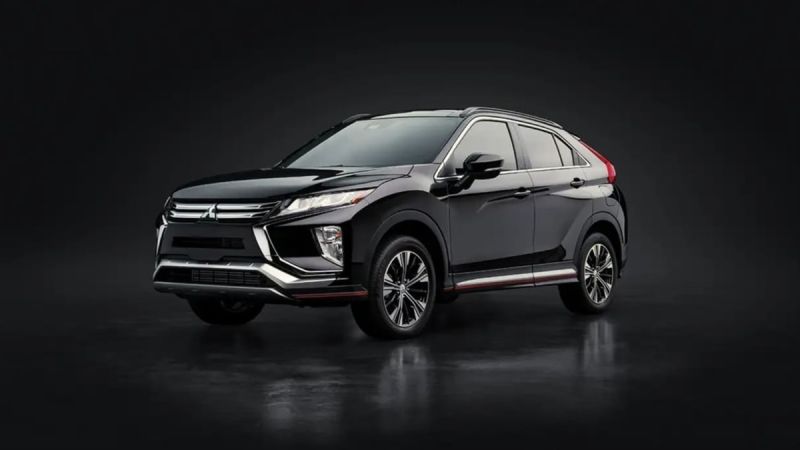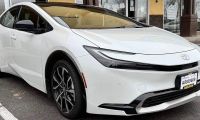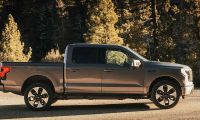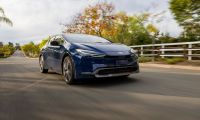The Mitsubishi Eclipse Cross was a new model two years ago and is the smallest vehicle along with the Outlander and Outlander Sport in Mitsubishi's stable of SUVs. It competes against the Honda HR-V, the sporty Hyundai Kona and the adventure-oriented Subaru Crosstrek. See how it stays up.
This week we drive the top-of-the-line 2020 Mitsubishi Eclipse Cross SEL 1.5T S-AWC trim.
What’s new for 2020?
All-wheel drive is no longer standard for most trim levels, and the SE trim includes additional advanced safety features for the 2020 model year change.
Features & Options
The top trim 2020 Mitsubishi Eclipse Cross SEL 1.5T S-AWC ($28,595) comes standard with black 18-inch alloy wheels, heated front seats, a remote touchpad controller for the infotainment system, Apple CarPlay and Android Auto, voice controls, satellite radio, and a second USB port.
The SE L also comes with push-button start, a leather-wrapped steering wheel, a six-speaker stereo system, dual-zone climate control, and a rear-seat center armrest. Safety equipment includes forward emergency braking with pedestrian detection, lane departure warning, blind-spot monitoring with rear cross-traffic alert, and automatic high beams.
The SEL trim gets additional goodies like LED headlights, leather upholstery, a power-adjustable driver's seat, a head-up display, and a surround-view parking camera system.
The optional Touring package ($2,100) added a panoramic sunroof, an auto-dimming rearview mirror, a premium Rockford Fosgate stereo system, a heated steering wheel, heated rear seats, high-speed emergency braking, and adaptive cruise control. Total MSRP including destination: $32,720.

Interior Highlights
The range-topping SEL S-AWC feels a lot more upscale than many compact SUV crossovers. It still comes with extensive hard plastic, a lot of which comes in piano black, but there’s also plenty of soft-touch surfaces. We made liberal use of the heated front seats and heated steering wheel providing extra comfort on cold Colorado mornings.
Legroom is good for taller drivers with the adjustable seat and tilt/telescoping steering wheel and it’s easy to find the perfect driving position. Visibility is the only issue from inside with the split rear window reminding us of a Prius hatchback.
The infotainment system's remote touchpad is intuitive and easy to use. The central display also works as a touchscreen. A full suite of driver aids and active safety features was included on this SEL tester. The back seat is not the biggest in the segment but adequate for two adults. We do like that the back seats have the ability to recline. And the Touring package features heated rear seats for extra passenger comfort.
There’s 22.6 cubic feet of cargo space behind the rear seat and 48.9 cubic feet with the rear seat folded down, putting the Eclipse Cross above average for this class.
Engine & Fuel Mileage Specs
Power comes from a turbocharged 1.5-liter four-cylinder engine producing 152 horsepower and 184 lb-ft of torque. It comes mated with a continuously variable automatic transmission. Our tester came with Mitsubishi’s All-Wheel Control all-wheel-drive system.
Eclipse Cross gets an EPA estimated 25/26 city/highway mpg and 25 combined mpg using regular unleaded fuel.

Driving Dynamics
The new Eclipse Cross is the ideal size for urban driving and commuting. We found the 1.5-liter turbocharged engine provided a good amount of power for this size SUV. We pushed the small crossover hard up I-70 traveling west up into the mountains west of Denver, and never felt the engine needed more power. And the Continuously Variable Transmission worked well with the turbocharged 1.5-liter powerplant. The paddle shifters enable you to shift manually and works in concert with the 8-step Sport Mode gearbox.
The Eclipse Cross isn't the sportiest when pushing around tight mountain curves, but it works well in the city when navigating narrow urban streets. We thought the ride quality was a bit harsh over the dirt roads leading home, and road noise is prominent at highway speeds.
We particularly enjoyed the head-up display in the compact Mitsubishi SUV. This is luxury in this class and helps the driver keep eyes on the road making for a safer commute in traffic.

Conclusion
The all-new 2018 Mitsubishi Eclipse Cross SEL 1.5T S-AWC is a smart choice in the popular compact SUV/Crossover segment. It comes with plenty of standard features and an easy-to-use infotainment system. The 1.5-liter turbocharged engine delivers peppy performance and the CVT automatic doesn’t wind up like the competition.
The downside is the split rear wind is hard to see out of, and the ride quality is a bit rough over broken pavement and dirt roads. The fuel mileage is also less than other compact vehicles in this segment. The top-trim SEL comes with a host of safety features giving driver confidence in heavy city traffic. Top trim-level pricing can get pushed up with the top Touring package.
You Might Also Like: How The New Second-Generation Subaru Crosstrek Is Blowing Away Honda HR-V And Toyota C-HR
Denis Flierl has invested nearly 30 years in the automotive industry in a variety of roles. All of his reports are archived here. Follow Denis on Facebook, Twitter, Instagram, Subaru Report. Check back tomorrow for more news and updates!
Leave your comments below, share the article with friends and tweet it out to your followers!
Photo credit: Mitsubishi USA













Comments
The original Mitsubishi
Permalink
The original Mitsubishi Eclipse, that debuted back in 1990, was quite the performance bargain, with an available 2.0T, that made up to 195 HP in the US, and available with AWD in the GSX model. I did not own one, but they were quite potent, and once saw one give a Nissan 300ZX, with a more powerful V-6, a good run for its money on the highway as the two thought they were on the Autobahn. At any rate, this current Eclipse Cross, a CUV with a 1.5T pales by any comparison to the original Eclipse from three decades ago, and I am more than befuddled why Mitsubishi would choose to recycle the Eclipse name on such a pedestrian CUV, that is quite unexceptional in most ways, even compared to the subcompact competition, let alone the original Eclipse. Seriously Mitsubishi, either lose the Eclipse name from this "also ran" CUV, or upgrade it to something more worthy. It is hard to believe that something from so long ago is so superior in terms of styling and performance to what you are pushing out now.
I have a 2018 and I love it
Permalink
In reply to The original Mitsubishi by Digitaldoc (not verified)
I have a 2018 and I love it
I just had one of these as a
Permalink
I just had one of these as a rental. An SE, not SEL. I didn’t find the ride harsh at all. In fact, it’s quite soft. The engine though, is massively underpowered. 152hp, in a vehicle that’s 3500+lbs, just isn’t enough. And the CVT is awful. I typically HATE manual transmissions, but in this vehicle I found myself wanting one. But despite those issues, you know what annoyed me the most? The f*cking blinkers. The sounds they make, both choices, just bothered me. Bothered me enough to not use them. Something wrong with the normal relay clicking that Mitsubishi had to put in these electronic sounds? No, screw that. Even if everything else was perfect, which it’s far from, those blinkers would keep me from buying this vehicle.
Totally agree that the engine
Permalink
In reply to I just had one of these as a by Mike L (not verified)
Totally agree that the engine is underpowered, and the transmission does it no favors. The 2.0 turbo from the old Eclipse hatch in the 90s was more potent! Not sure why Mitsubishi is building such a lackluster vehicle in a crowded field.